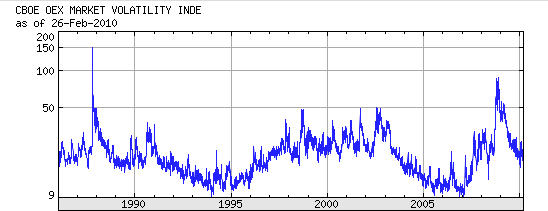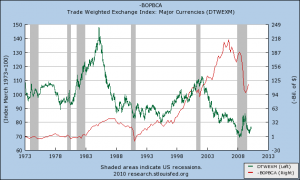VIX as a contrarian indicator
VIX is a measure of market volatility. Is volatility equal risk? Most people and finance textbook would tell you this is the case. Here I share with you two insightful pieces that surely offer you a fresh new perspective.
First, James Montier elaborates:
Nothing could be further from the truth. Volatility creates opportunity.

For instance, was the stock market more risky in 2007 or 2009? According to views of risk managers, 2007 was the less risky year, it had low volatility, which they happily fed into their risk models and concluded (falsely) that the world was a safe place to take risk. In contrast, these very same risk managers were saying that the world was exceptionally risky in 2009, and that one should be cutting back on risk. This is, of course, the complete opposite of what one should have been doing. In 2007, the evidence of a housing/credit bubble was plain to see, this suggested risk, valuations were high, it was time to scale back exposure. In 2009, bargains abounded, this was the perfect time to take ‘risk’ on, not to run away. Risk managers are the sorts of fellows that lend out umbrellas on fine days, and ask for them back when it starts to rain.
Second, Wall Street Journal has a wonderful piece with the similar idea —extreme low volatility often implies high risk ahead; and extreme high volatility often comes with huge opportunities.
The stock market’s most closely followed volatility index dropped this past week to its lowest level in nearly two years. Some investors who study volatility believe low readings are a bullish indicator for stocks. Historically, the market has tended to rise as volatility falls, and vice versa.
So the latest numbers are a surefire buy signal, right? Not necessarily. Dig a little deeper and you might even spot a contrarian indicator telling you to sell.
The Chicago Board Options Exchange’s volatility index, or VIX, is a gauge of investor sentiment. But its predictive power is limited to tallies of trades that have been made in the past. “The VIX is an important tool,” says Ben Londergan, co-chief executive of Group One Trading. “But it’s not the be-all and end-all factor to time your entrances and exits to the market.”
…
If anything, the VIX is most useful as a contrarian indicator. When the index remains unusually high or low for an extended period of time, it can mean a major market change is in the offing. For instance, the VIX had trended downward, and stocks upward, for several years leading up to the Dow Jones Industrial Average’s record close on Oct. 9, 2007. Then the subprime meltdown sent stocks plummeting as a historic bear market took hold.
One year later, during the diciest moments of the financial crisis, the VIX spiked to a record high of 80, capping a yearlong rise. Then it reversed course and fell sharply as stock markets enjoyed their most dramatic rally in decades.
Right now the VIX isn’t pointing to a major market move, since it is just now settling into its historical range. Under normal circumstances, the index moves in a fairly narrow band, mostly between 10 and 20. Having drifted gently downward for months, the index now sits at 17.
The recent drop is partly the result of an unusually steady stock market rally: In eight consecutive sessions over the past two weeks, stocks gained a total of just 2.2%, an amount that could easily be erased in one trading session.
So how can traders best make use of this oft-misunderstood index? By studying what is happening in the futures market. Professional investors have traded futures contracts on the VIX since 2004. When the futures are significantly different from the VIX itself, it is a signal that the index—and possibly the stock market—could soon reverse course. When the futures are significantly lower, it could be a bullish signal. When they are markedly higher, it could be bearish.
The latter is the case now. As of Friday’s close, the July futures on the VIX were trading at 23.25 and August futures at 23.40, considerably higher than the VIX’s 17. That suggests the pros are bracing for more volatility as the year wears on. If they turn out to be right, that could bode poorly for stocks.
Peter Schiff refutes Paul Krugman
Peter Schiff’s rebuttal to Paul Krugman.
Economists jousting on China’s exchange rate, part 2
In this video, economists and investors summarize their position toward Chinese Yuan. These includes:
Paul Krugman – 2008 Nobel prize winner in economics
Stephen Roach – Morgan Stanley Asia Chairman, former chief economist at Morgan Stanley USA
Joseph Stiglitz – 2003 Nobel prize winner in economics
Jim O'neil – Chief economist at Goldman Sachs
Jim Rogers – Investor, former partner with George Soros
My position on this is:
1) Yuan will appreciate;
2) Economic models are not reliable to gauge Yuan's undervaluation;
3) Political pressure from the US won't do any good;
4) Yuan's appreciation will not solve US' trade deficit problem, and American consumers will feel the pinch.
Facebook vs. Google
From Economist.com: Facebook overtook Google to become America’s most popular website. Figures for the week ending March 13th showed that the social-networking site accounted for 7.1% of the country’s traffic, compared with Google’s 7.0%, the first time it has had a weekly lead. However, with revenues of $23.7 billion last year, Google remains easily the more profitable of the two.

Will currency depreciation solve the trade deficit problem?
The answer is plainly no. A depreciation of the US dollar will not remove the trade deficits. In 1970s, one dollar exchanged for 360 Japanese Yen. Now, one dollar is worth for only around 100 Yen. In other words, Yen has appreciated 72%. Still, Japan runs a huge trade surplus with the US today.
Exchange rate is just one of the many factors that drive the trade balance between two countries. Differences in interest rate, savings, growth rate, level of financial development (in terms of how easy to get access to consumer credit) all played a role.
Here I show a historical graph from St. Louis Fed, which looks at the relationship between trade-weighted dollar index (with major trading partners) and the US trade deficits. The green line is the dollar index (left axis), the higher the value, the more valuable the dollar. The red line is US trade deficits (right axis) in billions of dollars.
As shown in the graph, from mid 1980s to early 1990s, the dollar index dropped (or depreciation) against major currencies by over 40%, dropping from 150 to 85, and the trade deficits got eliminated.
During recent years, especially after 2002, the US dollar index declined from 110 to 70 (in 2008), another nearly 40% drop, however, the trade deficits soared. So there gotta be some other reasons that drive the trade balances.
How about the super easy monetary policy by the Greenspan Fed? The extended period of low interest rate after 9.11 helped fuel the housing bubble, creating a fake appreciation of household wealth…American consumers became more confident than ever, resulting in surge of consumption, and imports.
My conclusion is: currency is certainly a factor in determining trade balances, but it’s not all that matters. So don’t be fooled.
Finally, I wanted to entertain you with another piece of debate on the issue.
Stephen Roach: Take out Krugman’s baseball bat
Krugman portrayed the problem of global imbalances as solely coming out of China’s high saving rate and manipulation of its currency. Stephen Roach, Chairman of Morgan Stanley Asia, offers a more comprehensive perspective.
Americans have been saving nothing, consuming too much, and high on leverage. “Get your own house in order” before you carry stick toward others — that’s the sensible advice from Roach.
Cathy Mann calls for interest rate hike NOW
Interview of Brandeis economics professor Catherine Mann.
Krugman wants a trade war with China
Mr. Krugman is getting crazy these days. If his proposal was implemented, every country will engage in trade war like another Great Depression. Forget about recovery. This is simply stupid.
The final argument I hear about the renminbi is that it’s useless to make demands, because the Chinese will just get their backs up, refusing to bow to external pressure. The right answer is, so?
Here’s how the initial phases of a confrontation would play out – this is actually Fred Bergsten’s scenario, and I think he’s right. First, the United States declares that China is a currency manipulator, and demands that China stop its massive intervention. If China refuses, the United States imposes a countervailing duty on Chinese exports, say 25 percent. The EU quickly follows suit, arguing that if it doesn’t, China’s surplus will be diverted to Europe. I don’t know what Japan does.
Suppose that China then digs in its heels, and refuses to budge. From the US-EU point of view, that’s OK! The problem is China’s surplus, not the value of the renminbi per se – and countervailing duties will do much of the job of eliminating that surplus, even if China refuses to move the exchange rate.
And precisely because the United States can get what it wants whatever China does, the odds are that China would soon give in.
Look, I know that many economists have a visceral dislike for this kind of confrontational policy. But you have to bear in mind that the really outlandish actor here is China: never before in history has a nation followed this drastic a mercantilist policy. And for those who counsel patience, arguing that China can eventually be brought around: the acute damage from China’s currency policy is happening now, while the world is still in a liquidity trap. Getting China to rethink that policy years from now, when (one can hope) advanced economies have returned to more or less full employment, is worth very little.


